Angola, NY Map & Demographics
Angola Map
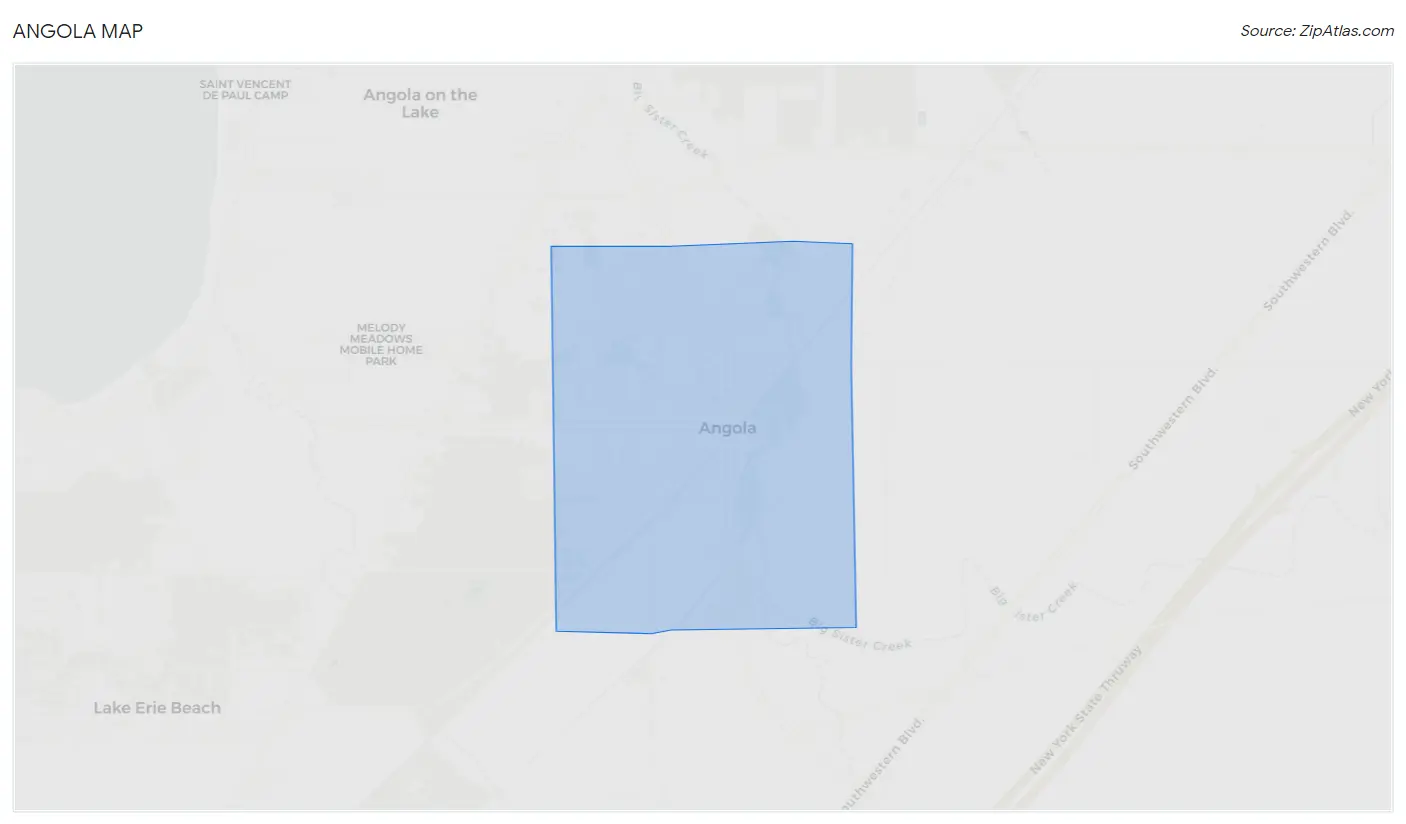
Angola Overview
$30,547
PER CAPITA INCOME
$82,883
AVG FAMILY INCOME
$71,809
AVG HOUSEHOLD INCOME
39.0%
WAGE / INCOME GAP [ % ]
61.0¢/ $1
WAGE / INCOME GAP [ $ ]
0.37
INEQUALITY / GINI INDEX
2,688
TOTAL POPULATION
1,402
MALE POPULATION
1,286
FEMALE POPULATION
109.02
MALES / 100 FEMALES
91.73
FEMALES / 100 MALES
37.9
MEDIAN AGE
3.1
AVG FAMILY SIZE
2.6
AVG HOUSEHOLD SIZE
1,464
LABOR FORCE [ PEOPLE ]
68.1%
PERCENT IN LABOR FORCE
2.7%
UNEMPLOYMENT RATE
Angola Zip Codes
Angola Area Codes
Income in Angola
Income Overview in Angola
Per Capita Income in Angola is $30,547, while median incomes of families and households are $82,883 and $71,809 respectively.
| Characteristic | Number | Measure |
| Per Capita Income | 2,688 | $30,547 |
| Median Family Income | 723 | $82,883 |
| Mean Family Income | 723 | $88,388 |
| Median Household Income | 1,017 | $71,809 |
| Mean Household Income | 1,017 | $79,011 |
| Income Deficit | 723 | $0 |
| Wage / Income Gap (%) | 2,688 | 39.01% |
| Wage / Income Gap ($) | 2,688 | 60.99¢ per $1 |
| Gini / Inequality Index | 2,688 | 0.37 |
Earnings by Sex in Angola
Average Earnings in Angola are $43,782, $48,605 for men and $29,643 for women, a difference of 39.0%.

| Sex | Number | Average Earnings |
| Male | 758 (51.6%) | $48,605 |
| Female | 710 (48.4%) | $29,643 |
| Total | 1,468 (100.0%) | $43,782 |
Earnings by Sex by Income Bracket in Angola
The most common earnings brackets in Angola are $45,000 to $49,999 for men (107 | 14.1%) and $7,500 to $9,999 for women (80 | 11.3%).
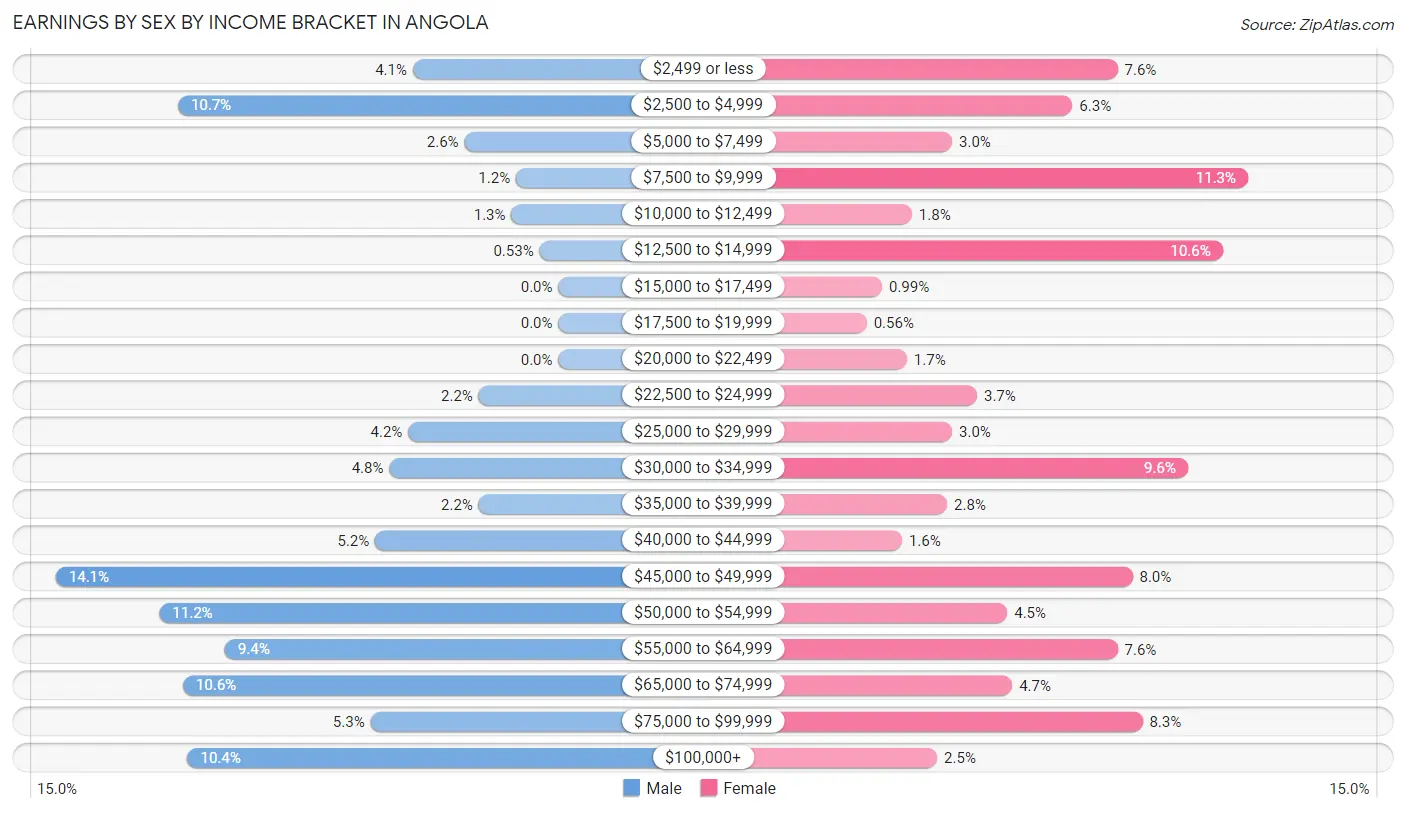
| Income | Male | Female |
| $2,499 or less | 31 (4.1%) | 54 (7.6%) |
| $2,500 to $4,999 | 81 (10.7%) | 45 (6.3%) |
| $5,000 to $7,499 | 20 (2.6%) | 21 (3.0%) |
| $7,500 to $9,999 | 9 (1.2%) | 80 (11.3%) |
| $10,000 to $12,499 | 10 (1.3%) | 13 (1.8%) |
| $12,500 to $14,999 | 4 (0.5%) | 75 (10.6%) |
| $15,000 to $17,499 | 0 (0.0%) | 7 (1.0%) |
| $17,500 to $19,999 | 0 (0.0%) | 4 (0.6%) |
| $20,000 to $22,499 | 0 (0.0%) | 12 (1.7%) |
| $22,500 to $24,999 | 17 (2.2%) | 26 (3.7%) |
| $25,000 to $29,999 | 32 (4.2%) | 21 (3.0%) |
| $30,000 to $34,999 | 36 (4.8%) | 68 (9.6%) |
| $35,000 to $39,999 | 17 (2.2%) | 20 (2.8%) |
| $40,000 to $44,999 | 39 (5.1%) | 11 (1.5%) |
| $45,000 to $49,999 | 107 (14.1%) | 57 (8.0%) |
| $50,000 to $54,999 | 85 (11.2%) | 32 (4.5%) |
| $55,000 to $64,999 | 71 (9.4%) | 54 (7.6%) |
| $65,000 to $74,999 | 80 (10.5%) | 33 (4.6%) |
| $75,000 to $99,999 | 40 (5.3%) | 59 (8.3%) |
| $100,000+ | 79 (10.4%) | 18 (2.5%) |
| Total | 758 (100.0%) | 710 (100.0%) |
Earnings by Sex by Educational Attainment in Angola
Average earnings in Angola are $50,965 for men and $32,004 for women, a difference of 37.2%. Men with an educational attainment of bachelor's degree enjoy the highest average annual earnings of $69,375, while those with high school diploma education earn the least with $45,875. Women with an educational attainment of bachelor's degree earn the most with the average annual earnings of $70,000, while those with less than high school education have the smallest earnings of $23,421.

| Educational Attainment | Male Income | Female Income |
| Less than High School | $56,488 | $23,421 |
| High School Diploma | $45,875 | $30,317 |
| College or Associate's Degree | $51,062 | $45,030 |
| Bachelor's Degree | $69,375 | $70,000 |
| Graduate Degree | - | - |
| Total | $50,965 | $32,004 |
Family Income in Angola
Family Income Brackets in Angola
According to the Angola family income data, there are 195 families falling into the $75,000 to $99,999 income range, which is the most common income bracket and makes up 27.0% of all families. Conversely, the less than $10,000 income bracket is the least frequent group with only 10 families (1.4%) belonging to this category.

| Income Bracket | # Families | % Families |
| Less than $10,000 | 10 | 1.4% |
| $10,000 to $14,999 | 29 | 4.0% |
| $15,000 to $24,999 | 27 | 3.7% |
| $25,000 to $34,999 | 64 | 8.9% |
| $35,000 to $49,999 | 70 | 9.7% |
| $50,000 to $74,999 | 137 | 18.9% |
| $75,000 to $99,999 | 195 | 27.0% |
| $100,000 to $149,999 | 135 | 18.7% |
| $150,000 to $199,999 | 16 | 2.2% |
| $200,000+ | 40 | 5.5% |
Family Income by Famaliy Size in Angola
3-person families (192 | 26.6%) account for the highest median family income in Angola with $89,643 per family, while 2-person families (327 | 45.2%) have the highest median income of $41,414 per family member.

| Income Bracket | # Families | Median Income |
| 2-Person Families | 327 (45.2%) | $82,829 |
| 3-Person Families | 192 (26.6%) | $89,643 |
| 4-Person Families | 133 (18.4%) | $78,125 |
| 5-Person Families | 14 (1.9%) | $0 |
| 6-Person Families | 35 (4.8%) | $0 |
| 7+ Person Families | 22 (3.0%) | $0 |
| Total | 723 (100.0%) | $82,883 |
Family Income by Number of Earners in Angola

| Number of Earners | # Families | Median Income |
| No Earners | 90 (12.4%) | $49,167 |
| 1 Earner | 269 (37.2%) | $41,563 |
| 2 Earners | 279 (38.6%) | $91,033 |
| 3+ Earners | 85 (11.8%) | $0 |
| Total | 723 (100.0%) | $82,883 |
Household Income in Angola
Household Income Brackets in Angola
With 261 households falling in the category, the $50,000 to $74,999 income range is the most frequent in Angola, accounting for 25.7% of all households. In contrast, only 16 households (1.6%) fall into the $150,000 to $199,999 income bracket, making it the least populous group.

| Income Bracket | # Households | % Households |
| Less than $10,000 | 29 | 2.9% |
| $10,000 to $14,999 | 44 | 4.3% |
| $15,000 to $24,999 | 63 | 6.2% |
| $25,000 to $34,999 | 68 | 6.7% |
| $35,000 to $49,999 | 110 | 10.8% |
| $50,000 to $74,999 | 261 | 25.7% |
| $75,000 to $99,999 | 215 | 21.1% |
| $100,000 to $149,999 | 171 | 16.8% |
| $150,000 to $199,999 | 16 | 1.6% |
| $200,000+ | 40 | 3.9% |
Household Income by Householder Age in Angola
The median household income in Angola is $71,809, with the highest median household income of $72,784 found in the 25 to 44 years age bracket for the primary householder. A total of 304 households (29.9%) fall into this category.

| Income Bracket | # Households | Median Income |
| 15 to 24 Years | 0 (0.0%) | $0 |
| 25 to 44 Years | 304 (29.9%) | $72,784 |
| 45 to 64 Years | 471 (46.3%) | $72,303 |
| 65+ Years | 242 (23.8%) | $60,000 |
| Total | 1,017 (100.0%) | $71,809 |
Poverty in Angola
Income Below Poverty by Sex and Age in Angola
With 9.1% poverty level for males and 10.3% for females among the residents of Angola, 18 to 24 year old males and 75 year old and over females are the most vulnerable to poverty, with 23 males (31.5%) and 22 females (27.9%) in their respective age groups living below the poverty level.
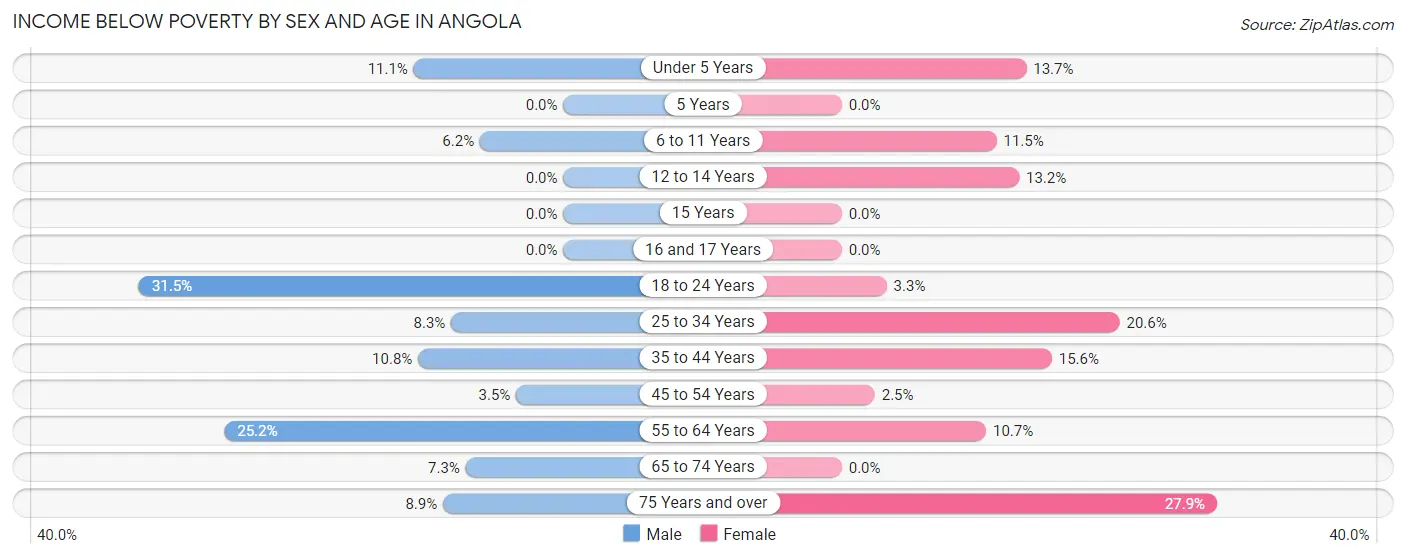
| Age Bracket | Male | Female |
| Under 5 Years | 9 (11.1%) | 10 (13.7%) |
| 5 Years | 0 (0.0%) | 0 (0.0%) |
| 6 to 11 Years | 7 (6.2%) | 10 (11.5%) |
| 12 to 14 Years | 0 (0.0%) | 5 (13.2%) |
| 15 Years | 0 (0.0%) | 0 (0.0%) |
| 16 and 17 Years | 0 (0.0%) | 0 (0.0%) |
| 18 to 24 Years | 23 (31.5%) | 4 (3.3%) |
| 25 to 34 Years | 16 (8.3%) | 33 (20.6%) |
| 35 to 44 Years | 11 (10.8%) | 29 (15.6%) |
| 45 to 54 Years | 9 (3.5%) | 6 (2.5%) |
| 55 to 64 Years | 37 (25.2%) | 12 (10.7%) |
| 65 to 74 Years | 10 (7.2%) | 0 (0.0%) |
| 75 Years and over | 5 (8.9%) | 22 (27.9%) |
| Total | 127 (9.1%) | 131 (10.3%) |
Income Above Poverty by Sex and Age in Angola
According to the poverty statistics in Angola, males aged 5 years and females aged 5 years are the age groups that are most secure financially, with 100.0% of males and 100.0% of females in these age groups living above the poverty line.
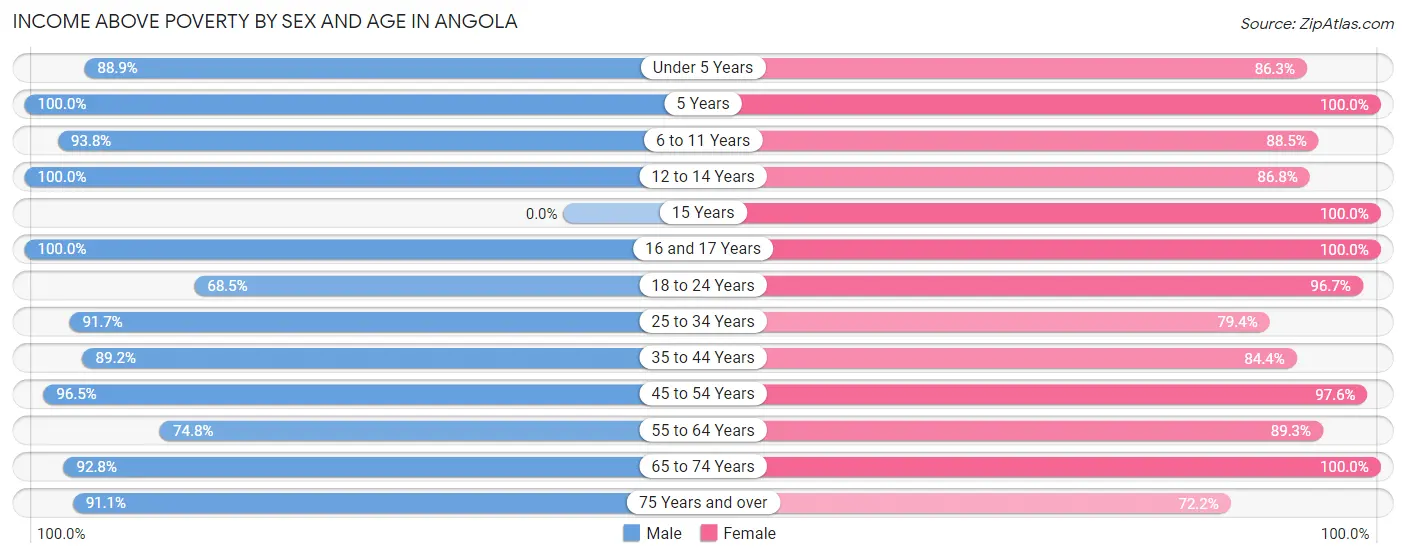
| Age Bracket | Male | Female |
| Under 5 Years | 72 (88.9%) | 63 (86.3%) |
| 5 Years | 21 (100.0%) | 3 (100.0%) |
| 6 to 11 Years | 106 (93.8%) | 77 (88.5%) |
| 12 to 14 Years | 89 (100.0%) | 33 (86.8%) |
| 15 Years | 0 (0.0%) | 22 (100.0%) |
| 16 and 17 Years | 133 (100.0%) | 29 (100.0%) |
| 18 to 24 Years | 50 (68.5%) | 116 (96.7%) |
| 25 to 34 Years | 176 (91.7%) | 127 (79.4%) |
| 35 to 44 Years | 91 (89.2%) | 157 (84.4%) |
| 45 to 54 Years | 248 (96.5%) | 239 (97.6%) |
| 55 to 64 Years | 110 (74.8%) | 100 (89.3%) |
| 65 to 74 Years | 128 (92.7%) | 121 (100.0%) |
| 75 Years and over | 51 (91.1%) | 57 (72.2%) |
| Total | 1,275 (90.9%) | 1,144 (89.7%) |
Income Below Poverty Among Married-Couple Families in Angola
The poverty statistics for married-couple families in Angola show that 1.5% or 6 of the total 408 families live below the poverty line. Families with 3 or 4 children have the highest poverty rate of 60.0%, comprising of 6 families. On the other hand, families with no children have the lowest poverty rate of 0.0%, which includes 0 families.

| Children | Above Poverty | Below Poverty |
| No Children | 201 (100.0%) | 0 (0.0%) |
| 1 or 2 Children | 182 (100.0%) | 0 (0.0%) |
| 3 or 4 Children | 4 (40.0%) | 6 (60.0%) |
| 5 or more Children | 15 (100.0%) | 0 (0.0%) |
| Total | 402 (98.5%) | 6 (1.5%) |
Income Below Poverty Among Single-Parent Households in Angola
According to the poverty data in Angola, 20.2% or 22 single-father households and 10.2% or 21 single-mother households are living below the poverty line. Among single-father households, those with no children have the highest poverty rate, with 22 households (40.0%) experiencing poverty. Likewise, among single-mother households, those with no children have the highest poverty rate, with 7 households (19.4%) falling below the poverty line.

| Children | Single Father | Single Mother |
| No Children | 22 (40.0%) | 7 (19.4%) |
| 1 or 2 Children | 0 (0.0%) | 14 (10.8%) |
| 3 or 4 Children | 0 (0.0%) | 0 (0.0%) |
| 5 or more Children | 0 (0.0%) | 0 (0.0%) |
| Total | 22 (20.2%) | 21 (10.2%) |
Income Below Poverty Among Married-Couple vs Single-Parent Households in Angola
The poverty data for Angola shows that 6 of the married-couple family households (1.5%) and 43 of the single-parent households (13.7%) are living below the poverty level. Within the married-couple family households, those with 3 or 4 children have the highest poverty rate, with 6 households (60.0%) falling below the poverty line. Among the single-parent households, those with no children have the highest poverty rate, with 29 household (31.9%) living below poverty.

| Children | Married-Couple Families | Single-Parent Households |
| No Children | 0 (0.0%) | 29 (31.9%) |
| 1 or 2 Children | 0 (0.0%) | 14 (7.9%) |
| 3 or 4 Children | 6 (60.0%) | 0 (0.0%) |
| 5 or more Children | 0 (0.0%) | 0 (0.0%) |
| Total | 6 (1.5%) | 43 (13.7%) |
Race in Angola
The most populous races in Angola are White / Caucasian (2,513 | 93.5%), Black / African American (90 | 3.4%), and Hispanic or Latino (49 | 1.8%).

| Race | # Population | % Population |
| Asian | 42 | 1.6% |
| Black / African American | 90 | 3.4% |
| Hawaiian / Pacific | 0 | 0.0% |
| Hispanic or Latino | 49 | 1.8% |
| Native / Alaskan | 4 | 0.2% |
| White / Caucasian | 2,513 | 93.5% |
| Two or more Races | 33 | 1.2% |
| Some other Race | 6 | 0.2% |
| Total | 2,688 | 100.0% |
Ancestry in Angola
The most populous ancestries reported in Angola are German (815 | 30.3%), Italian (644 | 24.0%), Irish (603 | 22.4%), Polish (370 | 13.8%), and American (147 | 5.5%), together accounting for 95.9% of all Angola residents.
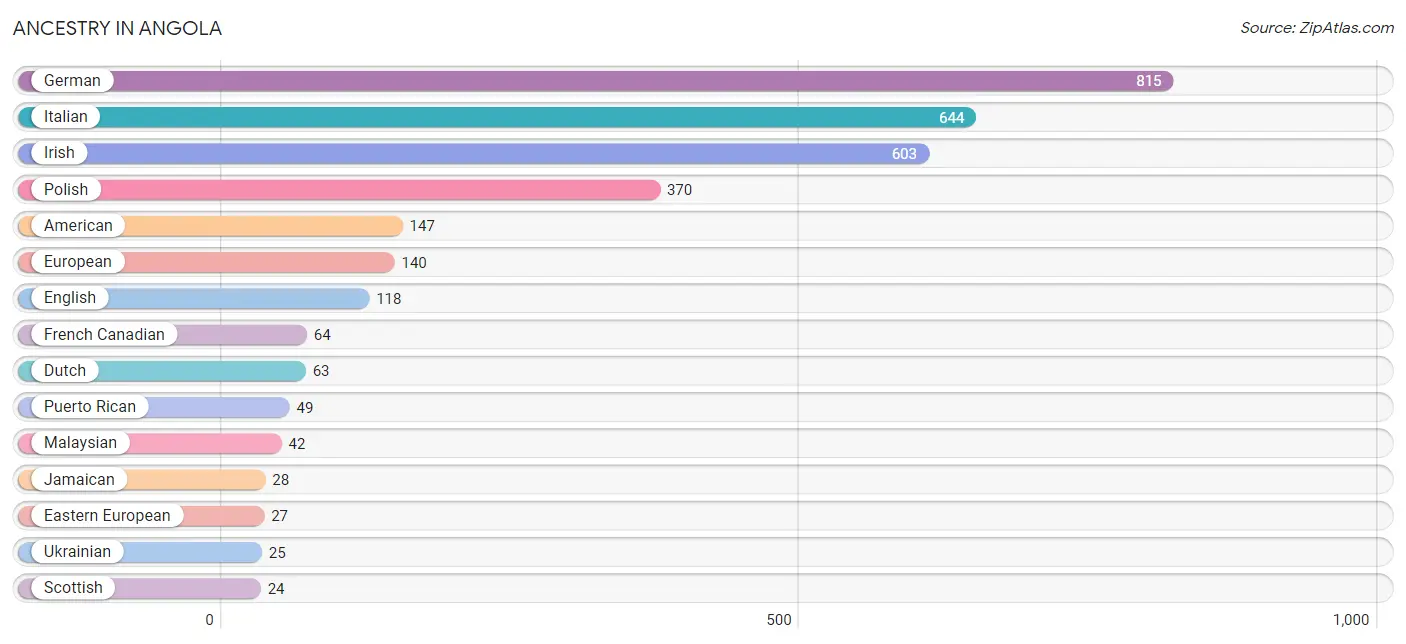
| Ancestry | # Population | % Population |
| American | 147 | 5.5% |
| Czech | 6 | 0.2% |
| Dutch | 63 | 2.3% |
| Eastern European | 27 | 1.0% |
| English | 118 | 4.4% |
| European | 140 | 5.2% |
| French | 19 | 0.7% |
| French Canadian | 64 | 2.4% |
| German | 815 | 30.3% |
| Greek | 6 | 0.2% |
| Hungarian | 9 | 0.3% |
| Irish | 603 | 22.4% |
| Iroquois | 4 | 0.2% |
| Italian | 644 | 24.0% |
| Jamaican | 28 | 1.0% |
| Malaysian | 42 | 1.6% |
| Northern European | 11 | 0.4% |
| Polish | 370 | 13.8% |
| Puerto Rican | 49 | 1.8% |
| Scotch-Irish | 9 | 0.3% |
| Scottish | 24 | 0.9% |
| Slovak | 5 | 0.2% |
| Swedish | 15 | 0.6% |
| Ukrainian | 25 | 0.9% |
| Welsh | 20 | 0.7% | View All 25 Rows |
Immigrants in Angola
The most numerous immigrant groups reported in Angola came from Asia (42 | 1.6%), Laos (42 | 1.6%), South Eastern Asia (42 | 1.6%), Europe (39 | 1.5%), and Germany (39 | 1.5%), together accounting for 7.6% of all Angola residents.

| Immigration Origin | # Population | % Population |
| Asia | 42 | 1.6% |
| Caribbean | 12 | 0.4% |
| Europe | 39 | 1.5% |
| Germany | 39 | 1.5% |
| Jamaica | 12 | 0.4% |
| Laos | 42 | 1.6% |
| Latin America | 12 | 0.4% |
| South Eastern Asia | 42 | 1.6% |
| Western Europe | 39 | 1.5% | View All 9 Rows |
Sex and Age in Angola
Sex and Age in Angola
The most populous age groups in Angola are 50 to 54 Years (178 | 12.7%) for men and 45 to 49 Years (173 | 13.5%) for women.
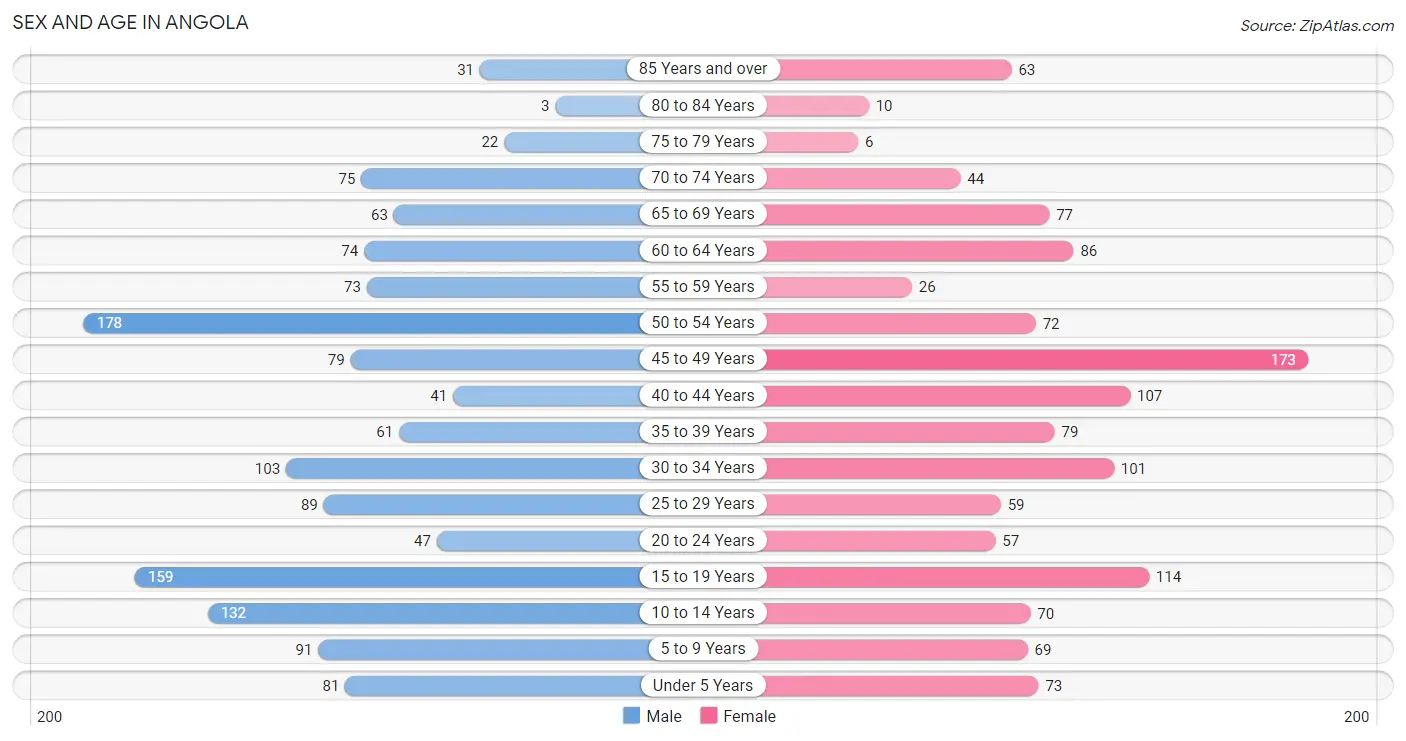
| Age Bracket | Male | Female |
| Under 5 Years | 81 (5.8%) | 73 (5.7%) |
| 5 to 9 Years | 91 (6.5%) | 69 (5.4%) |
| 10 to 14 Years | 132 (9.4%) | 70 (5.4%) |
| 15 to 19 Years | 159 (11.3%) | 114 (8.9%) |
| 20 to 24 Years | 47 (3.4%) | 57 (4.4%) |
| 25 to 29 Years | 89 (6.4%) | 59 (4.6%) |
| 30 to 34 Years | 103 (7.3%) | 101 (7.9%) |
| 35 to 39 Years | 61 (4.3%) | 79 (6.1%) |
| 40 to 44 Years | 41 (2.9%) | 107 (8.3%) |
| 45 to 49 Years | 79 (5.6%) | 173 (13.5%) |
| 50 to 54 Years | 178 (12.7%) | 72 (5.6%) |
| 55 to 59 Years | 73 (5.2%) | 26 (2.0%) |
| 60 to 64 Years | 74 (5.3%) | 86 (6.7%) |
| 65 to 69 Years | 63 (4.5%) | 77 (6.0%) |
| 70 to 74 Years | 75 (5.3%) | 44 (3.4%) |
| 75 to 79 Years | 22 (1.6%) | 6 (0.5%) |
| 80 to 84 Years | 3 (0.2%) | 10 (0.8%) |
| 85 Years and over | 31 (2.2%) | 63 (4.9%) |
| Total | 1,402 (100.0%) | 1,286 (100.0%) |
Families and Households in Angola
Median Family Size in Angola
The median family size in Angola is 3.09 persons per family, with married-couple families (408 | 56.4%) accounting for the largest median family size of 3.33 persons per family. On the other hand, single male/father families (109 | 15.1%) represent the smallest median family size with 2.02 persons per family.

| Family Type | # Families | Family Size |
| Married-Couple | 408 (56.4%) | 3.33 |
| Single Male/Father | 109 (15.1%) | 2.02 |
| Single Female/Mother | 206 (28.5%) | 3.17 |
| Total Families | 723 (100.0%) | 3.09 |
Median Household Size in Angola
The median household size in Angola is 2.61 persons per household, with married-couple households (408 | 40.1%) accounting for the largest median household size of 3.42 persons per household. non-family households (294 | 28.9%) represent the smallest median household size with 1.09 persons per household.

| Household Type | # Households | Household Size |
| Married-Couple | 408 (40.1%) | 3.42 |
| Single Male/Father | 109 (10.7%) | 2.42 |
| Single Female/Mother | 206 (20.3%) | 3.29 |
| Non-family | 294 (28.9%) | 1.09 |
| Total Households | 1,017 (100.0%) | 2.61 |
Household Size by Marriage Status in Angola
Out of a total of 1,017 households in Angola, 723 (71.1%) are family households, while 294 (28.9%) are nonfamily households. The most numerous type of family households are 2-person households, comprising 290, and the most common type of nonfamily households are 1-person households, comprising 268.

| Household Size | Family Households | Nonfamily Households |
| 1-Person Households | - | 268 (26.4%) |
| 2-Person Households | 290 (28.5%) | 26 (2.6%) |
| 3-Person Households | 203 (20.0%) | 0 (0.0%) |
| 4-Person Households | 132 (13.0%) | 0 (0.0%) |
| 5-Person Households | 22 (2.2%) | 0 (0.0%) |
| 6-Person Households | 54 (5.3%) | 0 (0.0%) |
| 7+ Person Households | 22 (2.2%) | 0 (0.0%) |
| Total | 723 (71.1%) | 294 (28.9%) |
Female Fertility in Angola
Fertility by Age in Angola
Average fertility rate in Angola is 56.0 births per 1,000 women. Women in the age bracket of 20 to 34 years have the highest fertility rate with 129.0 births per 1,000 women. Women in the age bracket of 20 to 34 years acount for 71.8% of all women with births.

| Age Bracket | Women with Births | Births / 1,000 Women |
| 15 to 19 years | 0 (0.0%) | 0.0 |
| 20 to 34 years | 28 (71.8%) | 129.0 |
| 35 to 50 years | 11 (28.2%) | 30.0 |
| Total | 39 (100.0%) | 56.0 |
Fertility by Age by Marriage Status in Angola
38.5% of women with births (39) in Angola are married. The highest percentage of unmarried women with births falls into 20 to 34 years age bracket with 85.7% of them unmarried at the time of birth, while the lowest percentage of unmarried women with births belong to 35 to 50 years age bracket with 0.0% of them unmarried.

| Age Bracket | Married | Unmarried |
| 15 to 19 years | 0 (0.0%) | 0 (0.0%) |
| 20 to 34 years | 4 (14.3%) | 24 (85.7%) |
| 35 to 50 years | 11 (100.0%) | 0 (0.0%) |
| Total | 15 (38.5%) | 24 (61.5%) |
Fertility by Education in Angola
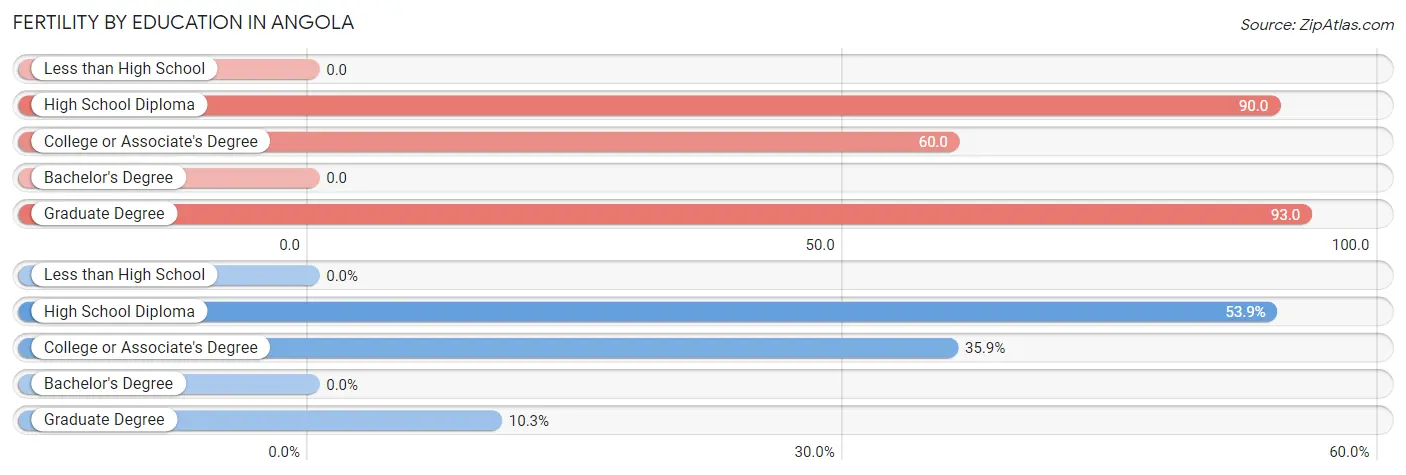
| Educational Attainment | Women with Births | Births / 1,000 Women |
| Less than High School | 0 (0.0%) | 0.0 |
| High School Diploma | 21 (53.8%) | 90.0 |
| College or Associate's Degree | 14 (35.9%) | 60.0 |
| Bachelor's Degree | 0 (0.0%) | 0.0 |
| Graduate Degree | 4 (10.3%) | 93.0 |
| Total | 39 (100.0%) | 56.0 |
Fertility by Education by Marriage Status in Angola
61.5% of women with births in Angola are unmarried. Women with the educational attainment of graduate degree are most likely to be married with 100.0% of them married at childbirth, while women with the educational attainment of college or associate's degree are least likely to be married with 100.0% of them unmarried at childbirth.

| Educational Attainment | Married | Unmarried |
| Less than High School | 0 (0.0%) | 0 (0.0%) |
| High School Diploma | 11 (52.4%) | 10 (47.6%) |
| College or Associate's Degree | 0 (0.0%) | 14 (100.0%) |
| Bachelor's Degree | 0 (0.0%) | 0 (0.0%) |
| Graduate Degree | 4 (100.0%) | 0 (0.0%) |
| Total | 15 (38.5%) | 24 (61.5%) |
Employment Characteristics in Angola
Employment by Class of Employer in Angola
Among the 1,375 employed individuals in Angola, private company employees (966 | 70.3%), not-for-profit organizations (115 | 8.4%), and local government employees (106 | 7.7%) make up the most common classes of employment.

| Employer Class | # Employees | % Employees |
| Private Company Employees | 966 | 70.3% |
| Self-Employed (Incorporated) | 79 | 5.8% |
| Self-Employed (Not Incorporated) | 30 | 2.2% |
| Not-for-profit Organizations | 115 | 8.4% |
| Local Government Employees | 106 | 7.7% |
| State Government Employees | 61 | 4.4% |
| Federal Government Employees | 18 | 1.3% |
| Unpaid Family Workers | 0 | 0.0% |
| Total | 1,375 | 100.0% |
Employment Status by Age in Angola
According to the labor force statistics for Angola, out of the total population over 16 years of age (2,150), 68.1% or 1,464 individuals are in the labor force, with 2.7% or 40 of them unemployed. The age group with the highest labor force participation rate is 45 to 54 years, with 93.0% or 467 individuals in the labor force. Within the labor force, the 65 to 74 years age range has the highest percentage of unemployed individuals, with 11.1% or 6 of them being unemployed.

| Age Bracket | In Labor Force | Unemployed |
| 16 to 19 Years | 144 (57.4%) | 0 (0.0%) |
| 20 to 24 Years | 85 (81.7%) | 0 (0.0%) |
| 25 to 29 Years | 105 (70.9%) | 0 (0.0%) |
| 30 to 34 Years | 186 (91.2%) | 4 (2.2%) |
| 35 to 44 Years | 250 (86.8%) | 24 (9.6%) |
| 45 to 54 Years | 467 (93.0%) | 6 (1.3%) |
| 55 to 59 Years | 77 (77.8%) | 0 (0.0%) |
| 60 to 64 Years | 91 (56.9%) | 0 (0.0%) |
| 65 to 74 Years | 54 (20.8%) | 6 (11.1%) |
| 75 Years and over | 5 (3.7%) | 0 (0.0%) |
| Total | 1,464 (68.1%) | 40 (2.7%) |
Employment Status by Educational Attainment in Angola
According to labor force statistics for Angola, 83.9% of individuals (1,175) out of the total population between 25 and 64 years of age (1,401) are in the labor force, with 2.9% or 34 of them being unemployed. The group with the highest labor force participation rate are those with the educational attainment of college / associate degree, with 90.3% or 492 individuals in the labor force. Within the labor force, individuals with less than high school education have the highest percentage of unemployment, with 5.7% or 5 of them being unemployed.

| Educational Attainment | In Labor Force | Unemployed |
| Less than High School | 87 (74.4%) | 7 (5.7%) |
| High School Diploma | 364 (79.1%) | 0 (0.0%) |
| College / Associate Degree | 492 (90.3%) | 21 (3.9%) |
| Bachelor's Degree or higher | 233 (83.5%) | 12 (4.3%) |
| Total | 1,175 (83.9%) | 41 (2.9%) |
Employment Occupations by Sex in Angola
Management, Business, Science and Arts Occupations
The most common Management, Business, Science and Arts occupations in Angola are Management (179 | 12.6%), Community & Social Service (132 | 9.3%), Arts, Media & Entertainment (61 | 4.3%), Health Diagnosing & Treating (61 | 4.3%), and Education Instruction & Library (48 | 3.4%).
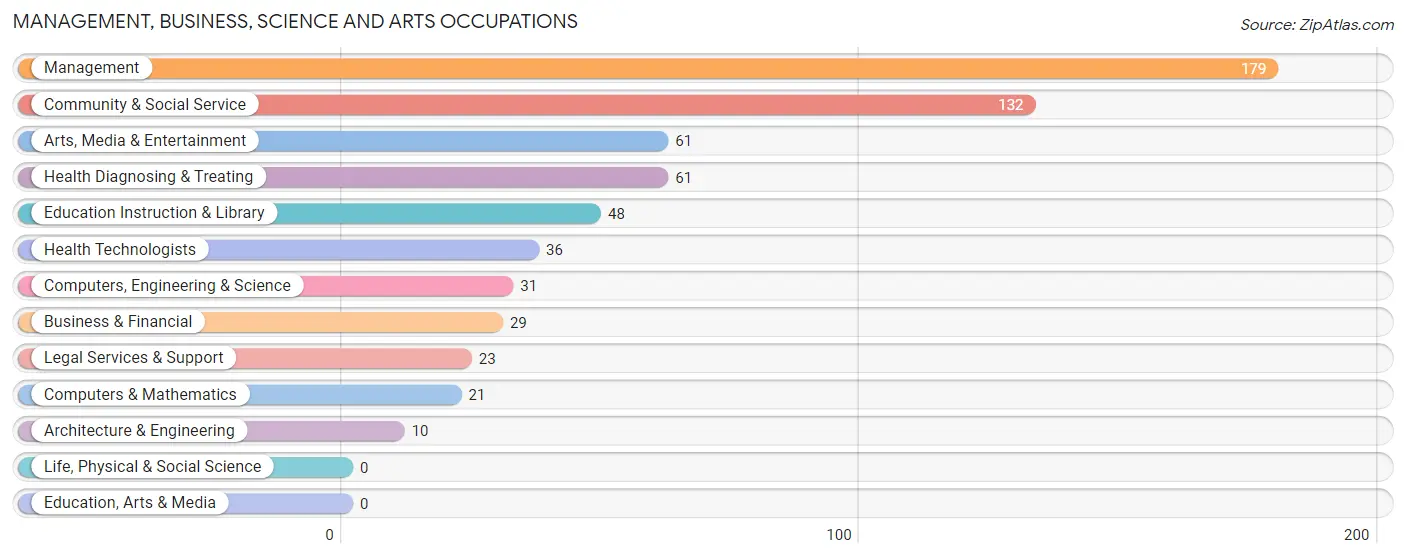
Management, Business, Science and Arts Occupations by Sex
Within the Management, Business, Science and Arts occupations in Angola, the most male-oriented occupations are Architecture & Engineering (100.0%), Computers, Engineering & Science (80.6%), and Legal Services & Support (73.9%), while the most female-oriented occupations are Education Instruction & Library (100.0%), Arts, Media & Entertainment (100.0%), and Community & Social Service (87.1%).
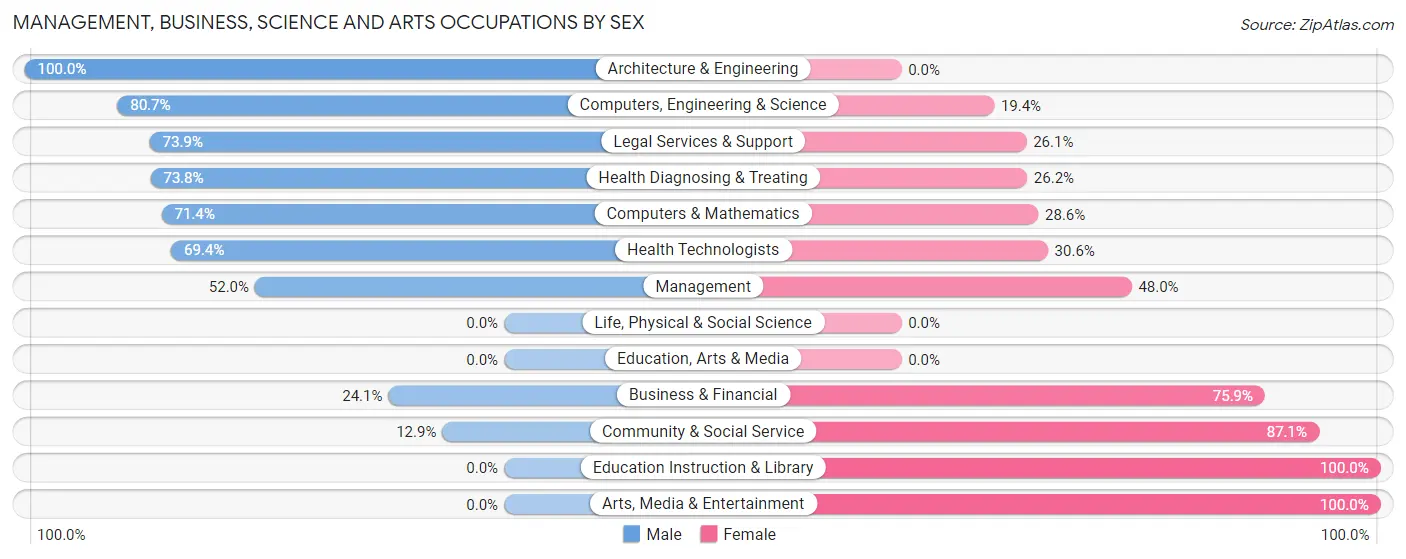
| Occupation | Male | Female |
| Management | 93 (52.0%) | 86 (48.0%) |
| Business & Financial | 7 (24.1%) | 22 (75.9%) |
| Computers, Engineering & Science | 25 (80.6%) | 6 (19.4%) |
| Computers & Mathematics | 15 (71.4%) | 6 (28.6%) |
| Architecture & Engineering | 10 (100.0%) | 0 (0.0%) |
| Life, Physical & Social Science | 0 (0.0%) | 0 (0.0%) |
| Community & Social Service | 17 (12.9%) | 115 (87.1%) |
| Education, Arts & Media | 0 (0.0%) | 0 (0.0%) |
| Legal Services & Support | 17 (73.9%) | 6 (26.1%) |
| Education Instruction & Library | 0 (0.0%) | 48 (100.0%) |
| Arts, Media & Entertainment | 0 (0.0%) | 61 (100.0%) |
| Health Diagnosing & Treating | 45 (73.8%) | 16 (26.2%) |
| Health Technologists | 25 (69.4%) | 11 (30.6%) |
| Total (Category) | 187 (43.3%) | 245 (56.7%) |
| Total (Overall) | 724 (50.8%) | 700 (49.2%) |
Services Occupations
The most common Services occupations in Angola are Food Preparation & Serving (114 | 8.0%), Healthcare Support (75 | 5.3%), Cleaning & Maintenance (22 | 1.5%), Security & Protection (11 | 0.8%), and Law Enforcement (11 | 0.8%).

Services Occupations by Sex
Within the Services occupations in Angola, the most male-oriented occupations are Security & Protection (100.0%), Law Enforcement (100.0%), and Cleaning & Maintenance (31.8%), while the most female-oriented occupations are Personal Care & Service (100.0%), Healthcare Support (76.0%), and Food Preparation & Serving (75.4%).

| Occupation | Male | Female |
| Healthcare Support | 18 (24.0%) | 57 (76.0%) |
| Security & Protection | 11 (100.0%) | 0 (0.0%) |
| Firefighting & Prevention | 0 (0.0%) | 0 (0.0%) |
| Law Enforcement | 11 (100.0%) | 0 (0.0%) |
| Food Preparation & Serving | 28 (24.6%) | 86 (75.4%) |
| Cleaning & Maintenance | 7 (31.8%) | 15 (68.2%) |
| Personal Care & Service | 0 (0.0%) | 7 (100.0%) |
| Total (Category) | 64 (28.0%) | 165 (72.1%) |
| Total (Overall) | 724 (50.8%) | 700 (49.2%) |
Sales and Office Occupations
The most common Sales and Office occupations in Angola are Office & Administration (241 | 16.9%), and Sales & Related (151 | 10.6%).

Sales and Office Occupations by Sex

| Occupation | Male | Female |
| Sales & Related | 109 (72.2%) | 42 (27.8%) |
| Office & Administration | 39 (16.2%) | 202 (83.8%) |
| Total (Category) | 148 (37.8%) | 244 (62.2%) |
| Total (Overall) | 724 (50.8%) | 700 (49.2%) |
Natural Resources, Construction and Maintenance Occupations
The most common Natural Resources, Construction and Maintenance occupations in Angola are Construction & Extraction (99 | 7.0%), and Installation, Maintenance & Repair (6 | 0.4%).

Natural Resources, Construction and Maintenance Occupations by Sex

| Occupation | Male | Female |
| Farming, Fishing & Forestry | 0 (0.0%) | 0 (0.0%) |
| Construction & Extraction | 99 (100.0%) | 0 (0.0%) |
| Installation, Maintenance & Repair | 6 (100.0%) | 0 (0.0%) |
| Total (Category) | 105 (100.0%) | 0 (0.0%) |
| Total (Overall) | 724 (50.8%) | 700 (49.2%) |
Production, Transportation and Moving Occupations
The most common Production, Transportation and Moving occupations in Angola are Production (155 | 10.9%), Transportation (58 | 4.1%), and Material Moving (53 | 3.7%).

Production, Transportation and Moving Occupations by Sex

| Occupation | Male | Female |
| Production | 148 (95.5%) | 7 (4.5%) |
| Transportation | 23 (39.7%) | 35 (60.3%) |
| Material Moving | 49 (92.4%) | 4 (7.5%) |
| Total (Category) | 220 (82.7%) | 46 (17.3%) |
| Total (Overall) | 724 (50.8%) | 700 (49.2%) |
Employment Industries by Sex in Angola
Employment Industries in Angola
The major employment industries in Angola include Manufacturing (224 | 15.7%), Health Care & Social Assistance (212 | 14.9%), Retail Trade (155 | 10.9%), Educational Services (149 | 10.5%), and Accommodation & Food Services (130 | 9.1%).
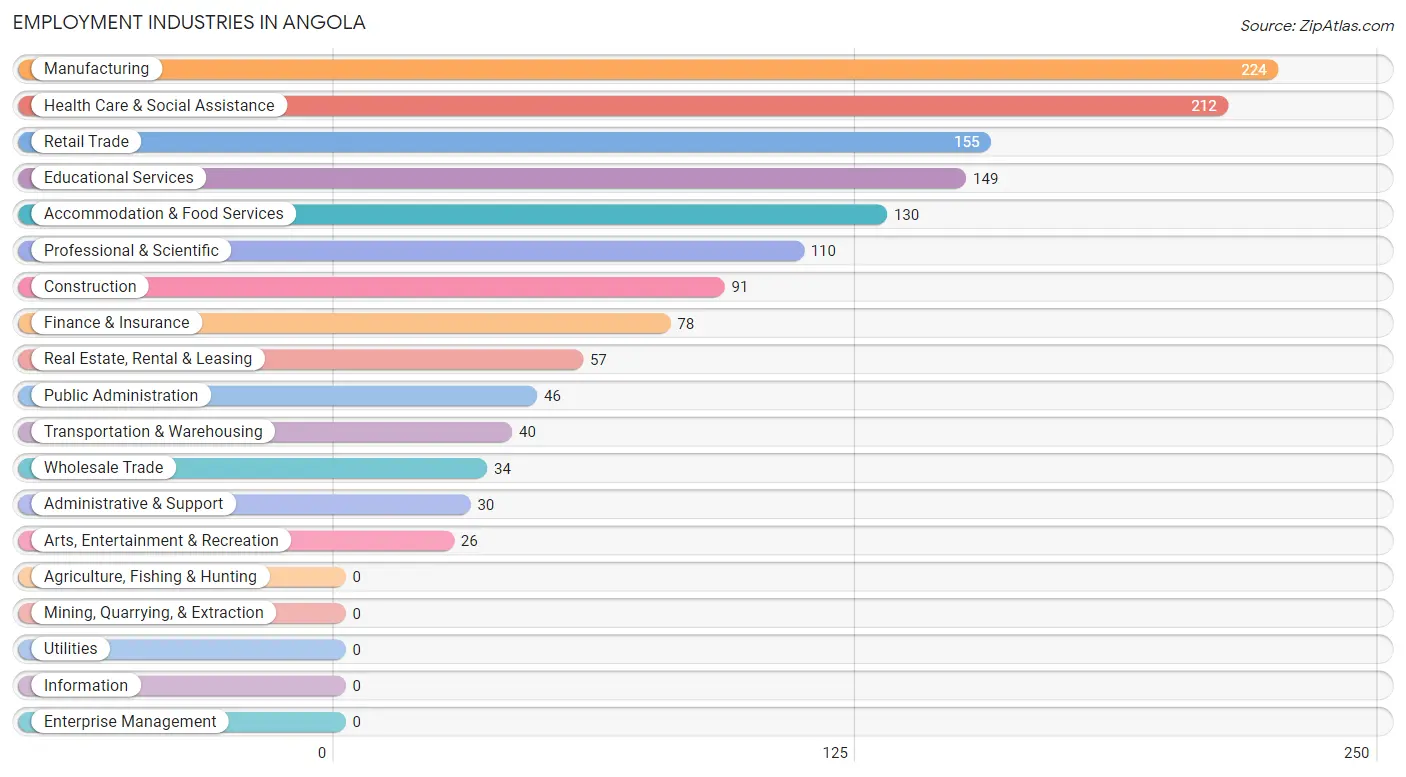
Employment Industries by Sex in Angola
The Angola industries that see more men than women are Construction (100.0%), Real Estate, Rental & Leasing (100.0%), and Arts, Entertainment & Recreation (100.0%), whereas the industries that tend to have a higher number of women are Administrative & Support (100.0%), Educational Services (100.0%), and Finance & Insurance (92.3%).
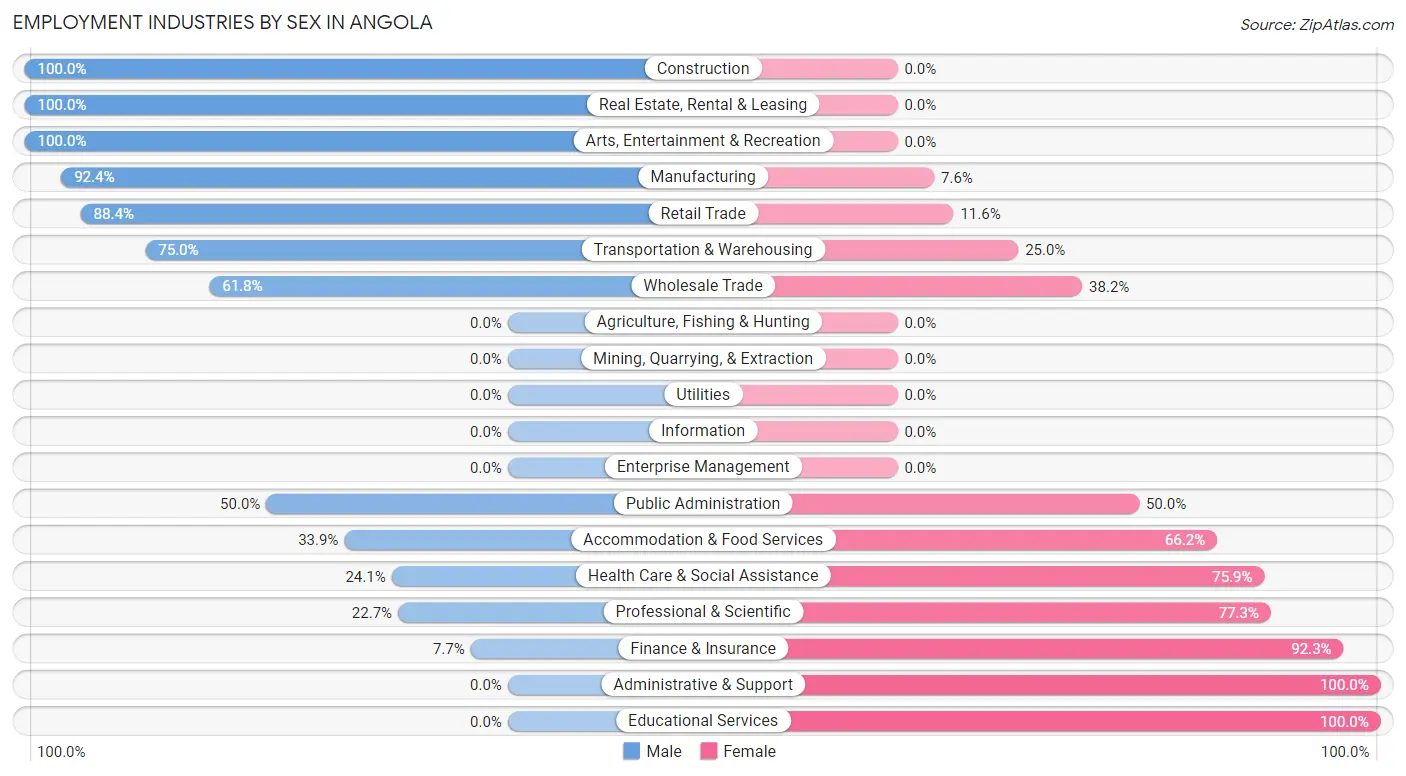
| Industry | Male | Female |
| Agriculture, Fishing & Hunting | 0 (0.0%) | 0 (0.0%) |
| Mining, Quarrying, & Extraction | 0 (0.0%) | 0 (0.0%) |
| Construction | 91 (100.0%) | 0 (0.0%) |
| Manufacturing | 207 (92.4%) | 17 (7.6%) |
| Wholesale Trade | 21 (61.8%) | 13 (38.2%) |
| Retail Trade | 137 (88.4%) | 18 (11.6%) |
| Transportation & Warehousing | 30 (75.0%) | 10 (25.0%) |
| Utilities | 0 (0.0%) | 0 (0.0%) |
| Information | 0 (0.0%) | 0 (0.0%) |
| Finance & Insurance | 6 (7.7%) | 72 (92.3%) |
| Real Estate, Rental & Leasing | 57 (100.0%) | 0 (0.0%) |
| Professional & Scientific | 25 (22.7%) | 85 (77.3%) |
| Enterprise Management | 0 (0.0%) | 0 (0.0%) |
| Administrative & Support | 0 (0.0%) | 30 (100.0%) |
| Educational Services | 0 (0.0%) | 149 (100.0%) |
| Health Care & Social Assistance | 51 (24.1%) | 161 (75.9%) |
| Arts, Entertainment & Recreation | 26 (100.0%) | 0 (0.0%) |
| Accommodation & Food Services | 44 (33.9%) | 86 (66.1%) |
| Public Administration | 23 (50.0%) | 23 (50.0%) |
| Total | 724 (50.8%) | 700 (49.2%) |
Education in Angola
School Enrollment in Angola
The most common levels of schooling among the 742 students in Angola are high school (237 | 31.9%), middle school (162 | 21.8%), and college / undergraduate (157 | 21.2%).

| School Level | # Students | % Students |
| Nursery / Preschool | 18 | 2.4% |
| Kindergarten | 11 | 1.5% |
| Elementary School | 150 | 20.2% |
| Middle School | 162 | 21.8% |
| High School | 237 | 31.9% |
| College / Undergraduate | 157 | 21.2% |
| Graduate / Professional | 7 | 0.9% |
| Total | 742 | 100.0% |
School Enrollment by Age by Funding Source in Angola
Out of a total of 742 students who are enrolled in schools in Angola, 131 (17.7%) attend a private institution, while the remaining 611 (82.3%) are enrolled in public schools. The age group of 20 to 24 year olds has the highest likelihood of being enrolled in private schools, with 45 (86.5% in the age bracket) enrolled. Conversely, the age group of 18 to 19 year olds has the lowest likelihood of being enrolled in a private school, with 89 (100.0% in the age bracket) attending a public institution.

| Age Bracket | Public School | Private School |
| 3 to 4 Year Olds | 0 (0.0%) | 0 (0.0%) |
| 5 to 9 Year Old | 140 (87.5%) | 20 (12.5%) |
| 10 to 14 Year Olds | 176 (87.1%) | 26 (12.9%) |
| 15 to 17 Year Olds | 144 (78.3%) | 40 (21.7%) |
| 18 to 19 Year Olds | 89 (100.0%) | 0 (0.0%) |
| 20 to 24 Year Olds | 7 (13.5%) | 45 (86.5%) |
| 25 to 34 Year Olds | 33 (100.0%) | 0 (0.0%) |
| 35 Years and over | 22 (100.0%) | 0 (0.0%) |
| Total | 611 (82.3%) | 131 (17.7%) |
Educational Attainment by Field of Study in Angola
Education (94 | 24.1%), business (86 | 22.1%), science & technology (74 | 19.0%), engineering (35 | 9.0%), and literature & languages (27 | 6.9%) are the most common fields of study among 390 individuals in Angola who have obtained a bachelor's degree or higher.
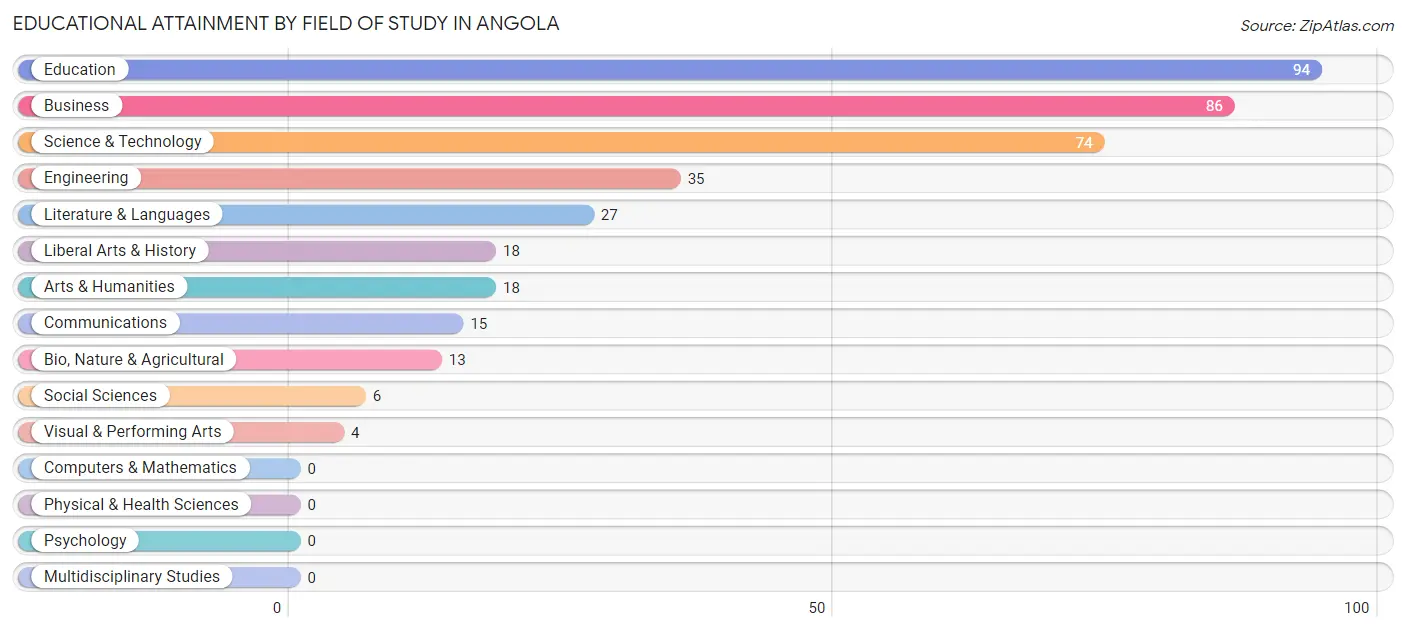
| Field of Study | # Graduates | % Graduates |
| Computers & Mathematics | 0 | 0.0% |
| Bio, Nature & Agricultural | 13 | 3.3% |
| Physical & Health Sciences | 0 | 0.0% |
| Psychology | 0 | 0.0% |
| Social Sciences | 6 | 1.5% |
| Engineering | 35 | 9.0% |
| Multidisciplinary Studies | 0 | 0.0% |
| Science & Technology | 74 | 19.0% |
| Business | 86 | 22.1% |
| Education | 94 | 24.1% |
| Literature & Languages | 27 | 6.9% |
| Liberal Arts & History | 18 | 4.6% |
| Visual & Performing Arts | 4 | 1.0% |
| Communications | 15 | 3.8% |
| Arts & Humanities | 18 | 4.6% |
| Total | 390 | 100.0% |
Transportation & Commute in Angola
Vehicle Availability by Sex in Angola
The most prevalent vehicle ownership categories in Angola are males with 2 vehicles (392, accounting for 57.0%) and females with 2 vehicles (400, making up 57.8%).

| Vehicles Available | Male | Female |
| No Vehicle | 8 (1.2%) | 0 (0.0%) |
| 1 Vehicle | 166 (24.1%) | 220 (32.5%) |
| 2 Vehicles | 392 (57.0%) | 400 (59.0%) |
| 3 Vehicles | 105 (15.3%) | 43 (6.3%) |
| 4 Vehicles | 11 (1.6%) | 4 (0.6%) |
| 5 or more Vehicles | 6 (0.9%) | 11 (1.6%) |
| Total | 688 (100.0%) | 678 (100.0%) |
Commute Time in Angola
The most frequently occuring commute durations in Angola are 35 to 39 minutes (227 commuters, 18.2%), 5 to 9 minutes (188 commuters, 15.0%), and 30 to 34 minutes (184 commuters, 14.7%).
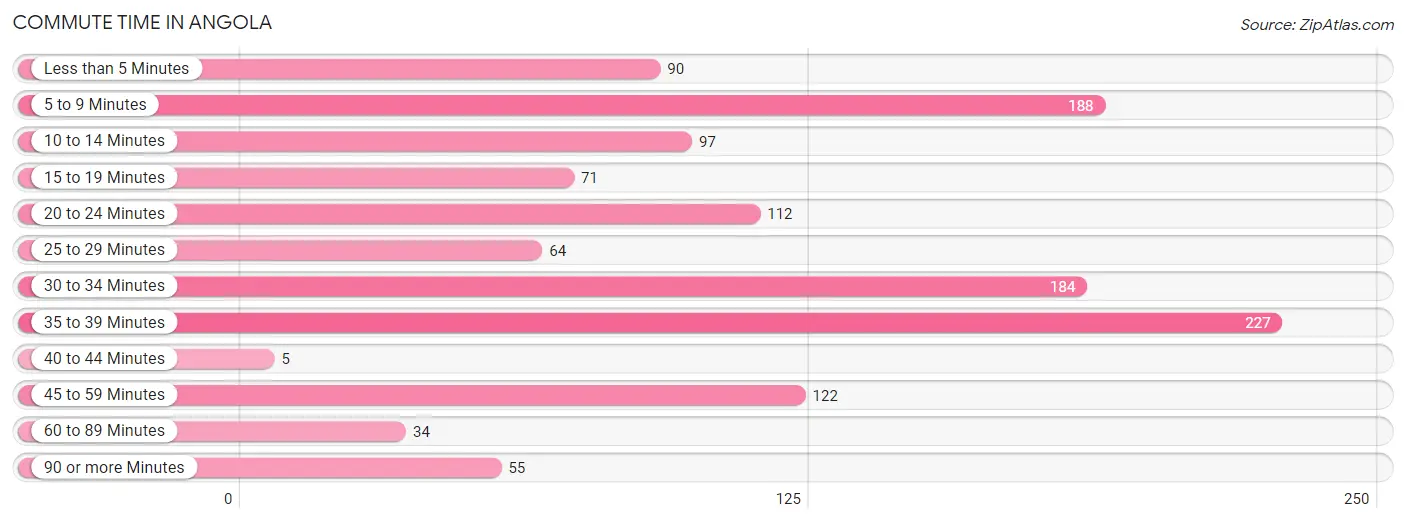
| Commute Time | # Commuters | % Commuters |
| Less than 5 Minutes | 90 | 7.2% |
| 5 to 9 Minutes | 188 | 15.0% |
| 10 to 14 Minutes | 97 | 7.8% |
| 15 to 19 Minutes | 71 | 5.7% |
| 20 to 24 Minutes | 112 | 9.0% |
| 25 to 29 Minutes | 64 | 5.1% |
| 30 to 34 Minutes | 184 | 14.7% |
| 35 to 39 Minutes | 227 | 18.2% |
| 40 to 44 Minutes | 5 | 0.4% |
| 45 to 59 Minutes | 122 | 9.8% |
| 60 to 89 Minutes | 34 | 2.7% |
| 90 or more Minutes | 55 | 4.4% |
Commute Time by Sex in Angola
The most common commute times in Angola are 35 to 39 minutes (193 commuters, 30.6%) for males and 30 to 34 minutes (134 commuters, 21.7%) for females.
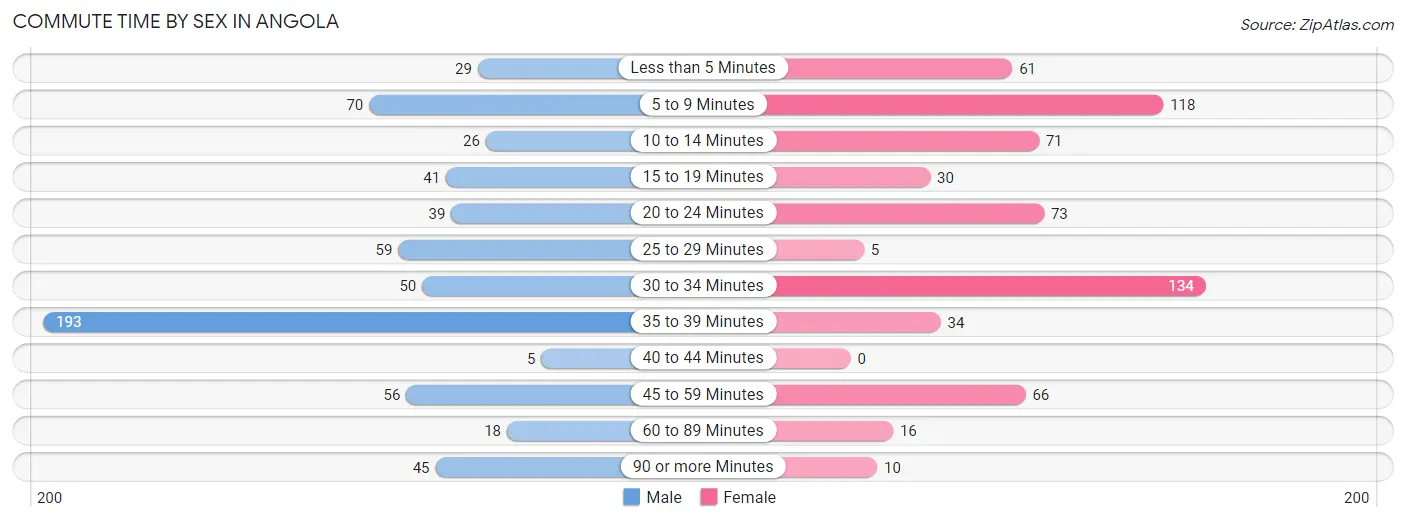
| Commute Time | Male | Female |
| Less than 5 Minutes | 29 (4.6%) | 61 (9.9%) |
| 5 to 9 Minutes | 70 (11.1%) | 118 (19.1%) |
| 10 to 14 Minutes | 26 (4.1%) | 71 (11.5%) |
| 15 to 19 Minutes | 41 (6.5%) | 30 (4.9%) |
| 20 to 24 Minutes | 39 (6.2%) | 73 (11.8%) |
| 25 to 29 Minutes | 59 (9.3%) | 5 (0.8%) |
| 30 to 34 Minutes | 50 (7.9%) | 134 (21.7%) |
| 35 to 39 Minutes | 193 (30.6%) | 34 (5.5%) |
| 40 to 44 Minutes | 5 (0.8%) | 0 (0.0%) |
| 45 to 59 Minutes | 56 (8.9%) | 66 (10.7%) |
| 60 to 89 Minutes | 18 (2.9%) | 16 (2.6%) |
| 90 or more Minutes | 45 (7.1%) | 10 (1.6%) |
Time of Departure to Work by Sex in Angola
The most frequent times of departure to work in Angola are 8:30 AM to 8:59 AM (146, 23.1%) for males and 7:30 AM to 7:59 AM (153, 24.8%) for females.
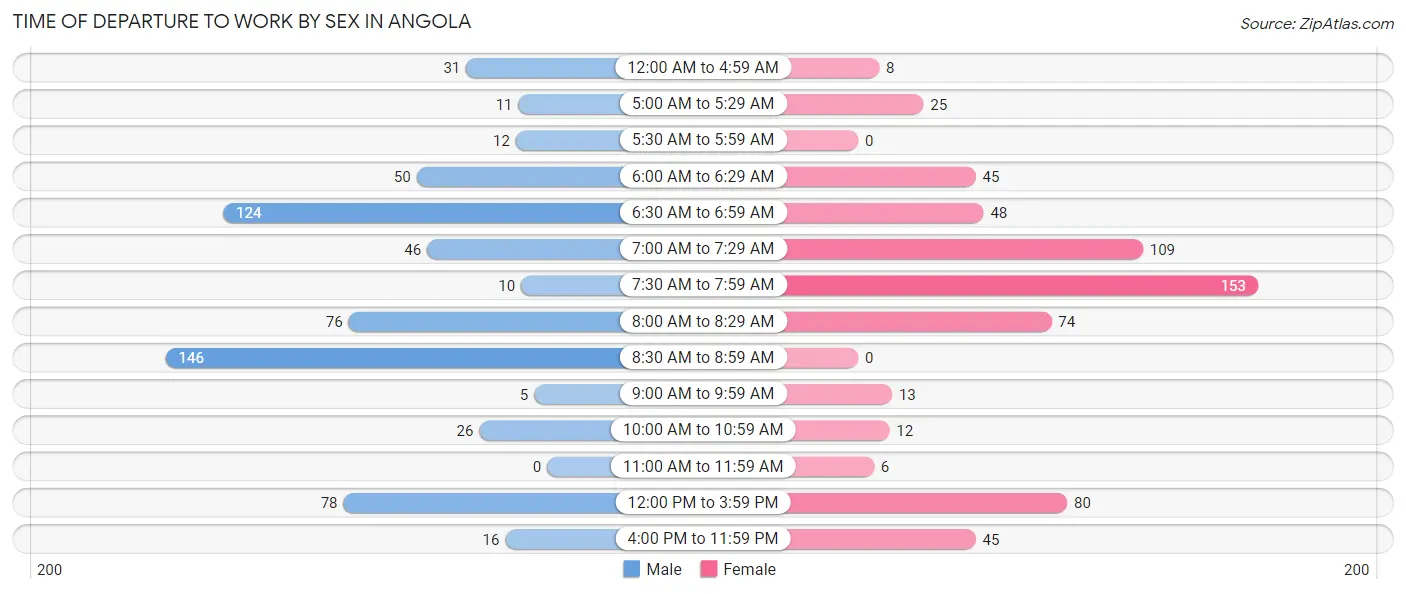
| Time of Departure | Male | Female |
| 12:00 AM to 4:59 AM | 31 (4.9%) | 8 (1.3%) |
| 5:00 AM to 5:29 AM | 11 (1.7%) | 25 (4.1%) |
| 5:30 AM to 5:59 AM | 12 (1.9%) | 0 (0.0%) |
| 6:00 AM to 6:29 AM | 50 (7.9%) | 45 (7.3%) |
| 6:30 AM to 6:59 AM | 124 (19.7%) | 48 (7.8%) |
| 7:00 AM to 7:29 AM | 46 (7.3%) | 109 (17.6%) |
| 7:30 AM to 7:59 AM | 10 (1.6%) | 153 (24.8%) |
| 8:00 AM to 8:29 AM | 76 (12.0%) | 74 (12.0%) |
| 8:30 AM to 8:59 AM | 146 (23.1%) | 0 (0.0%) |
| 9:00 AM to 9:59 AM | 5 (0.8%) | 13 (2.1%) |
| 10:00 AM to 10:59 AM | 26 (4.1%) | 12 (1.9%) |
| 11:00 AM to 11:59 AM | 0 (0.0%) | 6 (1.0%) |
| 12:00 PM to 3:59 PM | 78 (12.4%) | 80 (12.9%) |
| 4:00 PM to 11:59 PM | 16 (2.5%) | 45 (7.3%) |
| Total | 631 (100.0%) | 618 (100.0%) |
Housing Occupancy in Angola
Occupancy by Ownership in Angola
Of the total 1,017 dwellings in Angola, owner-occupied units account for 753 (74.0%), while renter-occupied units make up 264 (26.0%).

| Occupancy | # Housing Units | % Housing Units |
| Owner Occupied Housing Units | 753 | 74.0% |
| Renter-Occupied Housing Units | 264 | 26.0% |
| Total Occupied Housing Units | 1,017 | 100.0% |
Occupancy by Household Size in Angola

| Household Size | # Housing Units | % Housing Units |
| 1-Person Household | 268 | 26.4% |
| 2-Person Household | 316 | 31.1% |
| 3-Person Household | 203 | 20.0% |
| 4+ Person Household | 230 | 22.6% |
| Total Housing Units | 1,017 | 100.0% |
Occupancy by Ownership by Household Size in Angola

| Household Size | Owner-occupied | Renter-occupied |
| 1-Person Household | 193 (72.0%) | 75 (28.0%) |
| 2-Person Household | 265 (83.9%) | 51 (16.1%) |
| 3-Person Household | 117 (57.6%) | 86 (42.4%) |
| 4+ Person Household | 178 (77.4%) | 52 (22.6%) |
| Total Housing Units | 753 (74.0%) | 264 (26.0%) |
Occupancy by Educational Attainment in Angola

| Household Size | Owner-occupied | Renter-occupied |
| Less than High School | 52 (67.5%) | 25 (32.5%) |
| High School Diploma | 225 (77.6%) | 65 (22.4%) |
| College/Associate Degree | 322 (75.2%) | 106 (24.8%) |
| Bachelor's Degree or higher | 154 (69.4%) | 68 (30.6%) |
Occupancy by Age of Householder in Angola

| Age Bracket | # Households | % Households |
| Under 35 Years | 160 | 15.7% |
| 35 to 44 Years | 144 | 14.2% |
| 45 to 54 Years | 287 | 28.2% |
| 55 to 64 Years | 184 | 18.1% |
| 65 to 74 Years | 152 | 14.9% |
| 75 to 84 Years | 35 | 3.4% |
| 85 Years and Over | 55 | 5.4% |
| Total | 1,017 | 100.0% |
Housing Finances in Angola
Median Income by Occupancy in Angola

| Occupancy Type | # Households | Median Income |
| Owner-Occupied | 753 (74.0%) | $78,047 |
| Renter-Occupied | 264 (26.0%) | $46,250 |
| Average | 1,017 (100.0%) | $71,809 |
Occupancy by Householder Income Bracket in Angola
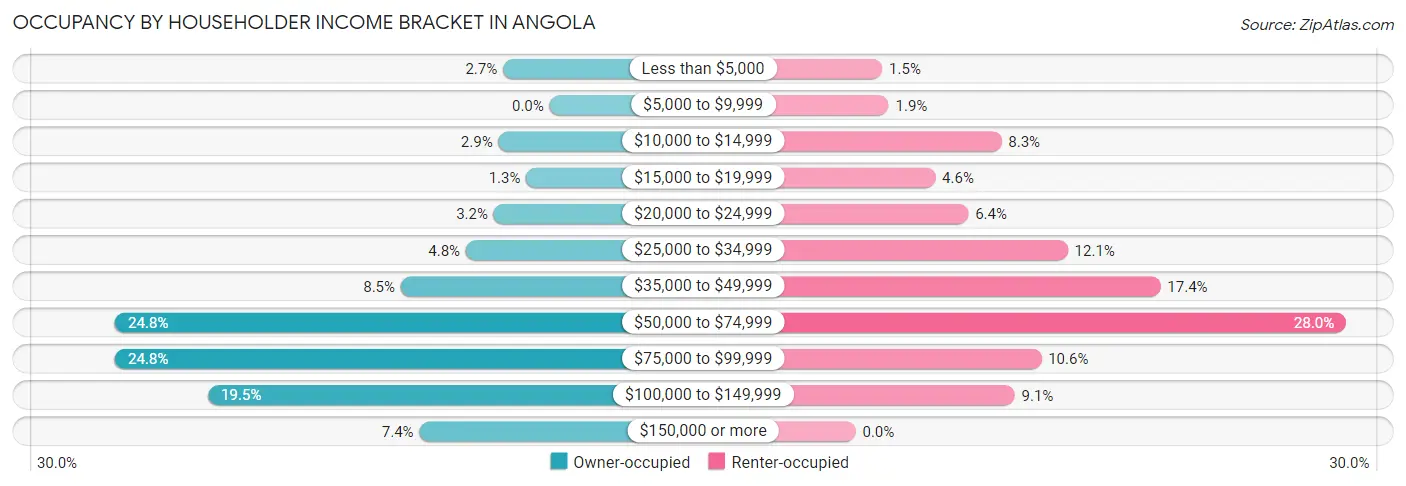
| Income Bracket | Owner-occupied | Renter-occupied |
| Less than $5,000 | 20 (2.7%) | 4 (1.5%) |
| $5,000 to $9,999 | 0 (0.0%) | 5 (1.9%) |
| $10,000 to $14,999 | 22 (2.9%) | 22 (8.3%) |
| $15,000 to $19,999 | 10 (1.3%) | 12 (4.5%) |
| $20,000 to $24,999 | 24 (3.2%) | 17 (6.4%) |
| $25,000 to $34,999 | 36 (4.8%) | 32 (12.1%) |
| $35,000 to $49,999 | 64 (8.5%) | 46 (17.4%) |
| $50,000 to $74,999 | 187 (24.8%) | 74 (28.0%) |
| $75,000 to $99,999 | 187 (24.8%) | 28 (10.6%) |
| $100,000 to $149,999 | 147 (19.5%) | 24 (9.1%) |
| $150,000 or more | 56 (7.4%) | 0 (0.0%) |
| Total | 753 (100.0%) | 264 (100.0%) |
Monthly Housing Cost Tiers in Angola

| Monthly Cost | Owner-occupied | Renter-occupied |
| Less than $300 | 20 (2.7%) | 0 (0.0%) |
| $300 to $499 | 52 (6.9%) | 6 (2.3%) |
| $500 to $799 | 98 (13.0%) | 87 (33.0%) |
| $800 to $999 | 123 (16.3%) | 63 (23.9%) |
| $1,000 to $1,499 | 218 (28.9%) | 93 (35.2%) |
| $1,500 to $1,999 | 203 (27.0%) | 0 (0.0%) |
| $2,000 to $2,499 | 19 (2.5%) | 0 (0.0%) |
| $2,500 to $2,999 | 9 (1.2%) | 0 (0.0%) |
| $3,000 or more | 11 (1.5%) | 0 (0.0%) |
| Total | 753 (100.0%) | 264 (100.0%) |
Physical Housing Characteristics in Angola
Housing Structures in Angola

| Structure Type | # Housing Units | % Housing Units |
| Single Unit, Detached | 745 | 73.3% |
| Single Unit, Attached | 16 | 1.6% |
| 2 Unit Apartments | 150 | 14.7% |
| 3 or 4 Unit Apartments | 52 | 5.1% |
| 5 to 9 Unit Apartments | 6 | 0.6% |
| 10 or more Apartments | 6 | 0.6% |
| Mobile Home / Other | 42 | 4.1% |
| Total | 1,017 | 100.0% |
Housing Structures by Occupancy in Angola

| Structure Type | Owner-occupied | Renter-occupied |
| Single Unit, Detached | 655 (87.9%) | 90 (12.1%) |
| Single Unit, Attached | 0 (0.0%) | 16 (100.0%) |
| 2 Unit Apartments | 56 (37.3%) | 94 (62.7%) |
| 3 or 4 Unit Apartments | 0 (0.0%) | 52 (100.0%) |
| 5 to 9 Unit Apartments | 0 (0.0%) | 6 (100.0%) |
| 10 or more Apartments | 0 (0.0%) | 6 (100.0%) |
| Mobile Home / Other | 42 (100.0%) | 0 (0.0%) |
| Total | 753 (74.0%) | 264 (26.0%) |
Housing Structures by Number of Rooms in Angola

| Number of Rooms | Owner-occupied | Renter-occupied |
| 1 Room | 0 (0.0%) | 0 (0.0%) |
| 2 or 3 Rooms | 7 (0.9%) | 22 (8.3%) |
| 4 or 5 Rooms | 102 (13.6%) | 176 (66.7%) |
| 6 or 7 Rooms | 331 (44.0%) | 55 (20.8%) |
| 8 or more Rooms | 313 (41.6%) | 11 (4.2%) |
| Total | 753 (100.0%) | 264 (100.0%) |
Housing Structure by Heating Type in Angola

| Heating Type | Owner-occupied | Renter-occupied |
| Utility Gas | 695 (92.3%) | 258 (97.7%) |
| Bottled, Tank, or LP Gas | 4 (0.5%) | 0 (0.0%) |
| Electricity | 26 (3.5%) | 6 (2.3%) |
| Fuel Oil or Kerosene | 13 (1.7%) | 0 (0.0%) |
| Coal or Coke | 0 (0.0%) | 0 (0.0%) |
| All other Fuels | 15 (2.0%) | 0 (0.0%) |
| No Fuel Used | 0 (0.0%) | 0 (0.0%) |
| Total | 753 (100.0%) | 264 (100.0%) |
Household Vehicle Usage in Angola

| Vehicles per Household | Owner-occupied | Renter-occupied |
| No Vehicle | 5 (0.7%) | 32 (12.1%) |
| 1 Vehicle | 290 (38.5%) | 161 (61.0%) |
| 2 Vehicles | 359 (47.7%) | 66 (25.0%) |
| 3 or more Vehicles | 99 (13.2%) | 5 (1.9%) |
| Total | 753 (100.0%) | 264 (100.0%) |
Real Estate & Mortgages in Angola
Real Estate and Mortgage Overview in Angola
| Characteristic | Without Mortgage | With Mortgage |
| Housing Units | 225 | 528 |
| Median Property Value | $142,200 | $141,600 |
| Median Household Income | $49,250 | $45 |
| Monthly Housing Costs | $673 | $4 |
| Real Estate Taxes | $4,143 | $46 |
Property Value by Mortgage Status in Angola

| Property Value | Without Mortgage | With Mortgage |
| Less than $50,000 | 16 (7.1%) | 54 (10.2%) |
| $50,000 to $99,999 | 52 (23.1%) | 31 (5.9%) |
| $100,000 to $299,999 | 140 (62.2%) | 424 (80.3%) |
| $300,000 to $499,999 | 10 (4.4%) | 0 (0.0%) |
| $500,000 to $749,999 | 0 (0.0%) | 13 (2.5%) |
| $750,000 to $999,999 | 0 (0.0%) | 0 (0.0%) |
| $1,000,000 or more | 7 (3.1%) | 6 (1.1%) |
| Total | 225 (100.0%) | 528 (100.0%) |
Household Income by Mortgage Status in Angola

| Household Income | Without Mortgage | With Mortgage |
| Less than $10,000 | 15 (6.7%) | 74 (14.0%) |
| $10,000 to $24,999 | 43 (19.1%) | 5 (0.9%) |
| $25,000 to $34,999 | 23 (10.2%) | 13 (2.5%) |
| $35,000 to $49,999 | 36 (16.0%) | 13 (2.5%) |
| $50,000 to $74,999 | 29 (12.9%) | 28 (5.3%) |
| $75,000 to $99,999 | 27 (12.0%) | 158 (29.9%) |
| $100,000 to $149,999 | 41 (18.2%) | 160 (30.3%) |
| $150,000 or more | 11 (4.9%) | 106 (20.1%) |
| Total | 225 (100.0%) | 528 (100.0%) |
Property Value to Household Income Ratio in Angola

| Value-to-Income Ratio | Without Mortgage | With Mortgage |
| Less than 2.0x | 80 (35.6%) | 83,730 (15,857.9%) |
| 2.0x to 2.9x | 31 (13.8%) | 353 (66.9%) |
| 3.0x to 3.9x | 9 (4.0%) | 116 (22.0%) |
| 4.0x or more | 90 (40.0%) | 27 (5.1%) |
| Total | 225 (100.0%) | 528 (100.0%) |
Real Estate Taxes by Mortgage Status in Angola

| Property Taxes | Without Mortgage | With Mortgage |
| Less than $800 | 3 (1.3%) | 0 (0.0%) |
| $800 to $1,499 | 12 (5.3%) | 17 (3.2%) |
| $800 to $1,499 | 205 (91.1%) | 0 (0.0%) |
| Total | 225 (100.0%) | 528 (100.0%) |
Health & Disability in Angola
Health Insurance Coverage by Age in Angola

| Age Bracket | With Coverage | Without Coverage |
| Under 6 Years | 178 (100.0%) | 0 (0.0%) |
| 6 to 18 Years | 608 (99.5%) | 3 (0.5%) |
| 19 to 25 Years | 118 (95.2%) | 6 (4.8%) |
| 26 to 34 Years | 305 (91.9%) | 27 (8.1%) |
| 35 to 44 Years | 288 (100.0%) | 0 (0.0%) |
| 45 to 54 Years | 496 (98.8%) | 6 (1.2%) |
| 55 to 64 Years | 237 (91.5%) | 22 (8.5%) |
| 65 to 74 Years | 259 (100.0%) | 0 (0.0%) |
| 75 Years and older | 135 (100.0%) | 0 (0.0%) |
| Total | 2,624 (97.6%) | 64 (2.4%) |
Health Insurance Coverage by Citizenship Status in Angola

| Citizenship Status | With Coverage | Without Coverage |
| Native Born | 178 (100.0%) | 0 (0.0%) |
| Foreign Born, Citizen | 608 (99.5%) | 3 (0.5%) |
| Foreign Born, not a Citizen | 118 (95.2%) | 6 (4.8%) |
Health Insurance Coverage by Household Income in Angola

| Household Income | With Coverage | Without Coverage |
| Under $25,000 | 159 (79.1%) | 42 (20.9%) |
| $25,000 to $49,999 | 408 (96.2%) | 16 (3.8%) |
| $50,000 to $74,999 | 730 (99.2%) | 6 (0.8%) |
| $75,000 to $99,999 | 599 (100.0%) | 0 (0.0%) |
| $100,000 and over | 696 (100.0%) | 0 (0.0%) |
Public vs Private Health Insurance Coverage by Age in Angola

| Age Bracket | Public Insurance | Private Insurance |
| Under 6 | 90 (50.6%) | 88 (49.4%) |
| 6 to 18 Years | 343 (56.1%) | 321 (52.5%) |
| 19 to 25 Years | 50 (40.3%) | 68 (54.8%) |
| 25 to 34 Years | 107 (32.2%) | 198 (59.6%) |
| 35 to 44 Years | 107 (37.1%) | 205 (71.2%) |
| 45 to 54 Years | 84 (16.7%) | 419 (83.5%) |
| 55 to 64 Years | 43 (16.6%) | 206 (79.5%) |
| 65 to 74 Years | 259 (100.0%) | 119 (46.0%) |
| 75 Years and over | 130 (96.3%) | 89 (65.9%) |
| Total | 1,213 (45.1%) | 1,713 (63.7%) |
Disability Status by Sex by Age in Angola

| Age Bracket | Male | Female |
| Under 5 Years | 0 (0.0%) | 0 (0.0%) |
| 5 to 17 Years | 79 (22.2%) | 6 (3.2%) |
| 18 to 34 Years | 70 (26.4%) | 31 (11.1%) |
| 35 to 64 Years | 34 (6.7%) | 111 (20.4%) |
| 65 to 74 Years | 37 (26.8%) | 41 (33.9%) |
| 75 Years and over | 44 (78.6%) | 54 (68.3%) |
Disability Class by Sex by Age in Angola
Disability Class: Hearing Difficulty

| Age Bracket | Male | Female |
| Under 5 Years | 0 (0.0%) | 0 (0.0%) |
| 5 to 17 Years | 0 (0.0%) | 0 (0.0%) |
| 18 to 34 Years | 16 (6.0%) | 15 (5.4%) |
| 35 to 64 Years | 15 (3.0%) | 10 (1.8%) |
| 65 to 74 Years | 21 (15.2%) | 0 (0.0%) |
| 75 Years and over | 32 (57.1%) | 24 (30.4%) |
Disability Class: Vision Difficulty

| Age Bracket | Male | Female |
| Under 5 Years | 0 (0.0%) | 0 (0.0%) |
| 5 to 17 Years | 0 (0.0%) | 0 (0.0%) |
| 18 to 34 Years | 14 (5.3%) | 7 (2.5%) |
| 35 to 64 Years | 0 (0.0%) | 57 (10.5%) |
| 65 to 74 Years | 0 (0.0%) | 6 (5.0%) |
| 75 Years and over | 5 (8.9%) | 4 (5.1%) |
Disability Class: Cognitive Difficulty

| Age Bracket | Male | Female |
| 5 to 17 Years | 79 (22.2%) | 6 (3.2%) |
| 18 to 34 Years | 52 (19.6%) | 9 (3.2%) |
| 35 to 64 Years | 5 (1.0%) | 21 (3.9%) |
| 65 to 74 Years | 0 (0.0%) | 13 (10.7%) |
| 75 Years and over | 5 (8.9%) | 18 (22.8%) |
Disability Class: Ambulatory Difficulty

| Age Bracket | Male | Female |
| 5 to 17 Years | 0 (0.0%) | 0 (0.0%) |
| 18 to 34 Years | 12 (4.5%) | 0 (0.0%) |
| 35 to 64 Years | 34 (6.7%) | 39 (7.2%) |
| 65 to 74 Years | 21 (15.2%) | 41 (33.9%) |
| 75 Years and over | 12 (21.4%) | 49 (62.0%) |
Disability Class: Self-Care Difficulty

| Age Bracket | Male | Female |
| 5 to 17 Years | 48 (13.5%) | 0 (0.0%) |
| 18 to 34 Years | 12 (4.5%) | 0 (0.0%) |
| 35 to 64 Years | 0 (0.0%) | 0 (0.0%) |
| 65 to 74 Years | 6 (4.3%) | 13 (10.7%) |
| 75 Years and over | 0 (0.0%) | 18 (22.8%) |
Technology Access in Angola
Computing Device Access in Angola

| Device Type | # Households | % Households |
| Desktop or Laptop | 725 | 71.3% |
| Smartphone | 870 | 85.6% |
| Tablet | 579 | 56.9% |
| No Computing Device | 84 | 8.3% |
| Total | 1,017 | 100.0% |
Internet Access in Angola

| Internet Type | # Households | % Households |
| Dial-Up Internet | 0 | 0.0% |
| Broadband Home | 637 | 62.6% |
| Cellular Data Only | 202 | 19.9% |
| Satellite Internet | 57 | 5.6% |
| No Internet | 126 | 12.4% |
| Total | 1,017 | 100.0% |
Angola Summary
Angola, New York is a small town located in the western part of the state, in the county of Erie. It is situated on the shores of Lake Erie, and is part of the Buffalo-Niagara Falls metropolitan area. The town has a population of approximately 9,000 people, and is known for its small-town charm and friendly atmosphere.
History
The area that is now Angola was first settled in 1804 by a group of settlers from Connecticut. The town was originally known as "New Connecticut," and was later renamed Angola after the African country. The town was officially incorporated in 1836.
In the early days, Angola was a farming community, with many of the settlers growing wheat, corn, and other crops. The town also had a thriving lumber industry, with many of the residents working in the sawmills and logging camps.
In the late 19th century, Angola began to experience a period of growth and development. The town was connected to the rest of the state by the Buffalo and Erie Railroad, and the population began to increase. The town also became a popular tourist destination, with many people coming to enjoy the lake and the nearby Niagara Falls.
Geography
Angola is located in the western part of New York State, in the county of Erie. It is situated on the shores of Lake Erie, and is part of the Buffalo-Niagara Falls metropolitan area. The town has a total area of 8.3 square miles, of which 8.2 square miles is land and 0.1 square miles is water.
The town is located in a region of rolling hills and valleys, and is surrounded by forests and farmland. The town is also home to several small lakes, including Lake Erie, which is the largest lake in the state.
Economy
The economy of Angola is largely based on tourism and manufacturing. The town is home to several tourist attractions, including the Angola Historical Society Museum, the Angola Beach State Park, and the Angola Lighthouse. The town also has several manufacturing companies, including a plastics factory and a metal fabrication plant.
The town also has a thriving retail sector, with several stores and restaurants located in the downtown area. The town also has a number of small businesses, including a local newspaper, a hardware store, and a bakery.
Demographics
As of the 2010 census, the population of Angola was 8,945. The racial makeup of the town was 95.3% White, 1.2% African American, 0.3% Native American, 0.7% Asian, 0.1% Pacific Islander, 0.7% from other races, and 1.7% from two or more races. Hispanic or Latino of any race were 2.7% of the population.
The median household income in Angola was $45,945, and the median family income was $51,945. The per capita income for the town was $20,945. About 8.3% of families and 10.2% of the population were below the poverty line, including 14.2% of those under age 18 and 5.2% of those age 65 or over.
Common Questions
What is Per Capita Income in Angola?
Per Capita income in Angola is $30,547.
What is the Median Family Income in Angola?
Median Family Income in Angola is $82,883.
What is the Median Household income in Angola?
Median Household Income in Angola is $71,809.
What is Income or Wage Gap in Angola?
Income or Wage Gap in Angola is 39.0%.
Women in Angola earn 61.0 cents for every dollar earned by a man.
What is Inequality or Gini Index in Angola?
Inequality or Gini Index in Angola is 0.37.
What is the Total Population of Angola?
Total Population of Angola is 2,688.
What is the Total Male Population of Angola?
Total Male Population of Angola is 1,402.
What is the Total Female Population of Angola?
Total Female Population of Angola is 1,286.
What is the Ratio of Males per 100 Females in Angola?
There are 109.02 Males per 100 Females in Angola.
What is the Ratio of Females per 100 Males in Angola?
There are 91.73 Females per 100 Males in Angola.
What is the Median Population Age in Angola?
Median Population Age in Angola is 37.9 Years.
What is the Average Family Size in Angola
Average Family Size in Angola is 3.1 People.
What is the Average Household Size in Angola
Average Household Size in Angola is 2.6 People.
How Large is the Labor Force in Angola?
There are 1,464 People in the Labor Forcein in Angola.
What is the Percentage of People in the Labor Force in Angola?
68.1% of People are in the Labor Force in Angola.
What is the Unemployment Rate in Angola?
Unemployment Rate in Angola is 2.7%.